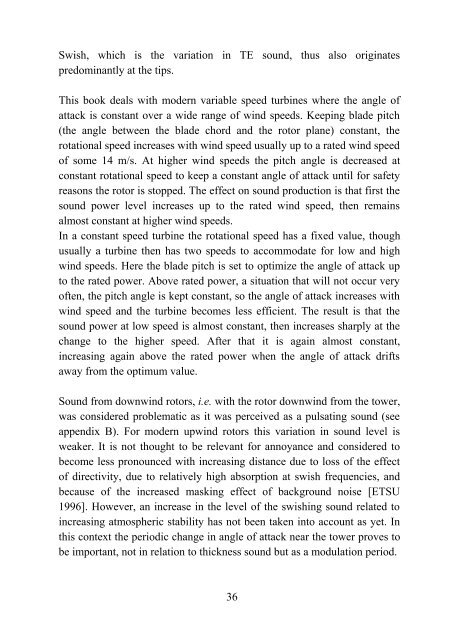The sounds of high winds
The sounds of high winds
The sounds of high winds
Create successful ePaper yourself
Turn your PDF publications into a flip-book with our unique Google optimized e-Paper software.
Swish, which is the variation in TE sound, thus also originates<br />
predominantly at the tips.<br />
This book deals with modern variable speed turbines where the angle <strong>of</strong><br />
attack is constant over a wide range <strong>of</strong> wind speeds. Keeping blade pitch<br />
(the angle between the blade chord and the rotor plane) constant, the<br />
rotational speed increases with wind speed usually up to a rated wind speed<br />
<strong>of</strong> some 14 m/s. At <strong>high</strong>er wind speeds the pitch angle is decreased at<br />
constant rotational speed to keep a constant angle <strong>of</strong> attack until for safety<br />
reasons the rotor is stopped. <strong>The</strong> effect on sound production is that first the<br />
sound power level increases up to the rated wind speed, then remains<br />
almost constant at <strong>high</strong>er wind speeds.<br />
In a constant speed turbine the rotational speed has a fixed value, though<br />
usually a turbine then has two speeds to accommodate for low and <strong>high</strong><br />
wind speeds. Here the blade pitch is set to optimize the angle <strong>of</strong> attack up<br />
to the rated power. Above rated power, a situation that will not occur very<br />
<strong>of</strong>ten, the pitch angle is kept constant, so the angle <strong>of</strong> attack increases with<br />
wind speed and the turbine becomes less efficient. <strong>The</strong> result is that the<br />
sound power at low speed is almost constant, then increases sharply at the<br />
change to the <strong>high</strong>er speed. After that it is again almost constant,<br />
increasing again above the rated power when the angle <strong>of</strong> attack drifts<br />
away from the optimum value.<br />
Sound from downwind rotors, i.e. with the rotor downwind from the tower,<br />
was considered problematic as it was perceived as a pulsating sound (see<br />
appendix B). For modern upwind rotors this variation in sound level is<br />
weaker. It is not thought to be relevant for annoyance and considered to<br />
become less pronounced with increasing distance due to loss <strong>of</strong> the effect<br />
<strong>of</strong> directivity, due to relatively <strong>high</strong> absorption at swish frequencies, and<br />
because <strong>of</strong> the increased masking effect <strong>of</strong> background noise [ETSU<br />
1996]. However, an increase in the level <strong>of</strong> the swishing sound related to<br />
increasing atmospheric stability has not been taken into account as yet. In<br />
this context the periodic change in angle <strong>of</strong> attack near the tower proves to<br />
be important, not in relation to thickness sound but as a modulation period.<br />
36
















